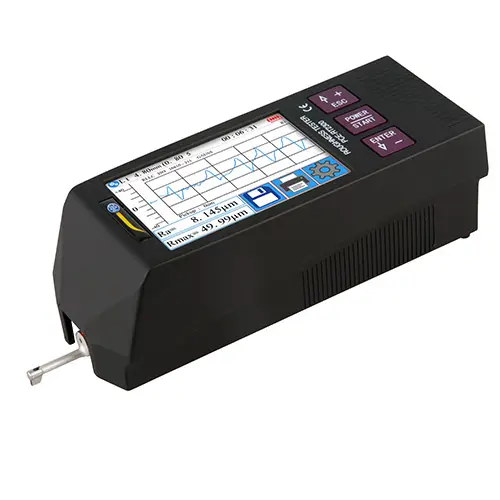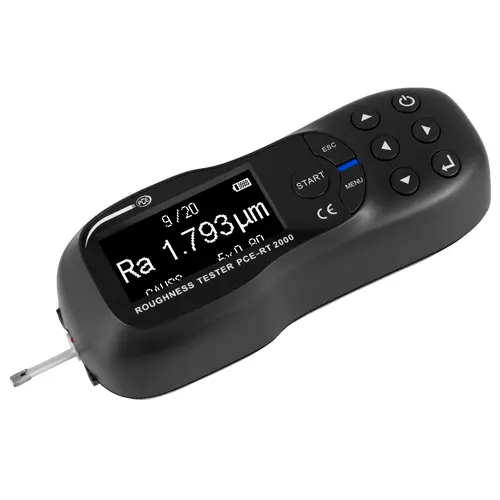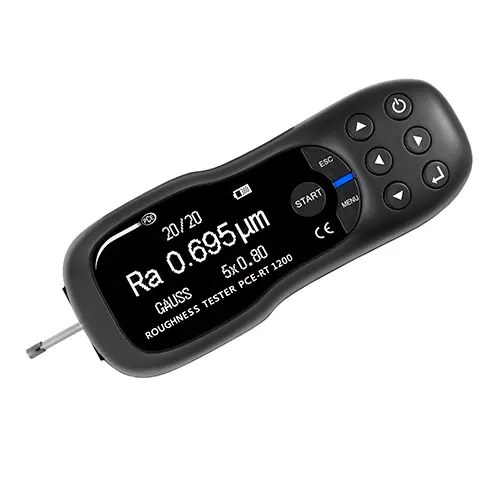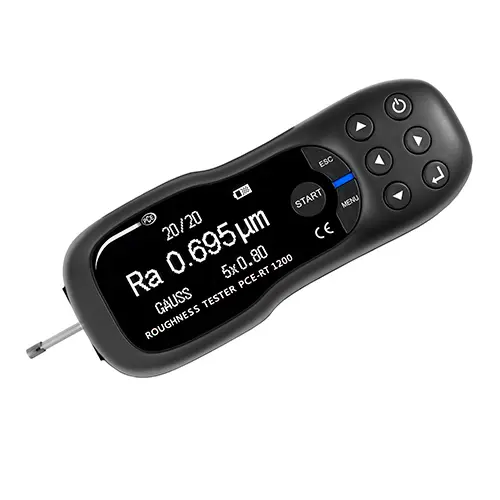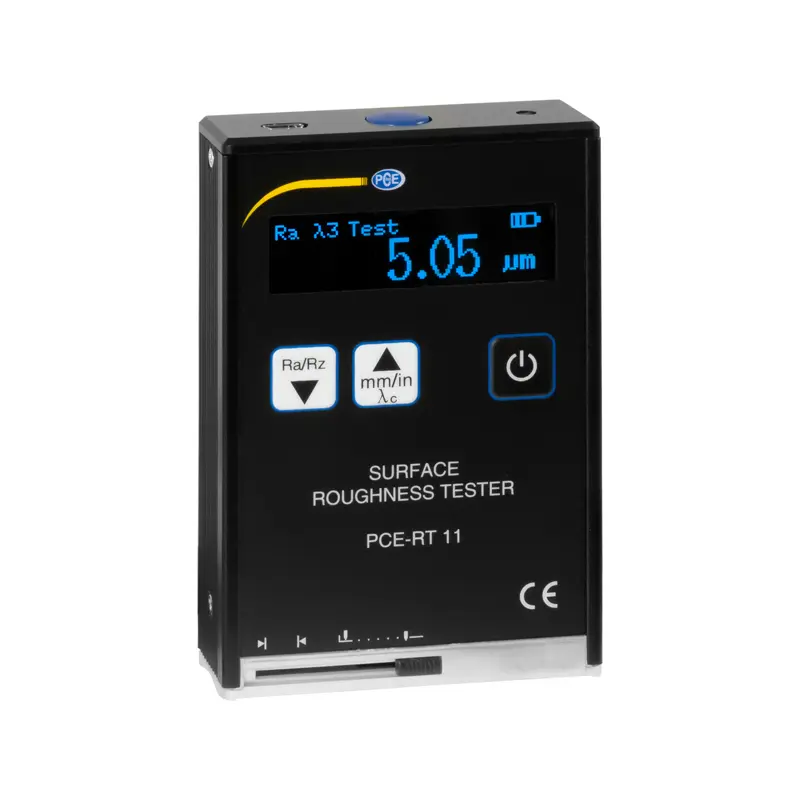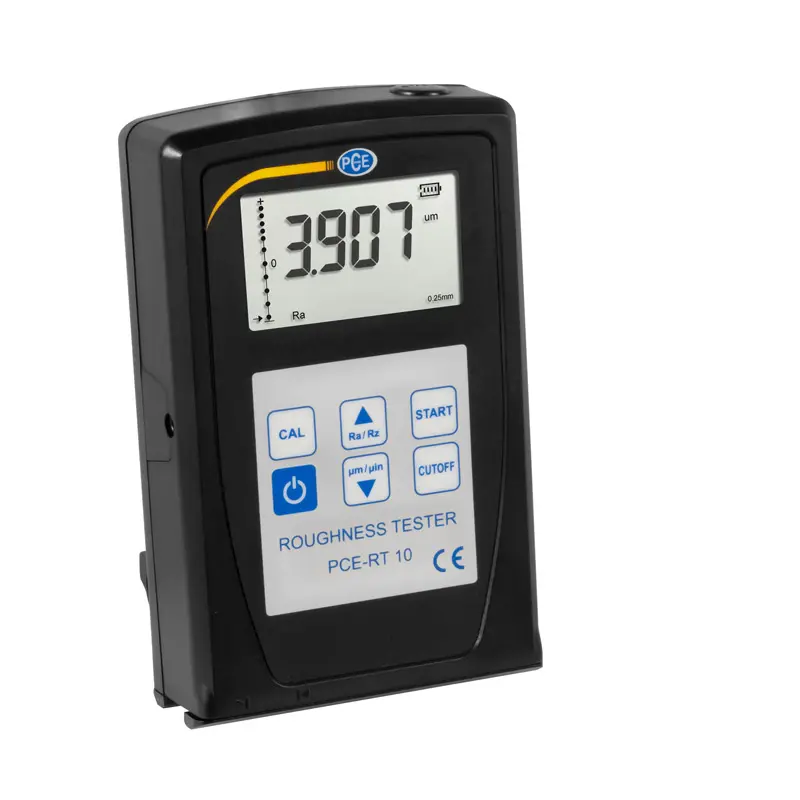Portable Roughness Tester
A Portable Roughness Tester is a handheld device used to measure the surface roughness of a material. It is a crucial tool for quality control and product consistency in industries such as manufacturing, automotive, and aerospace. A Roughness Tester typically measures the roughness parameters of a surface such as Ra, Rz, and Rq. These parameters are used to determine the surface texture and finish of a material. The Portable Roughness Tester can be used on a wide range of materials, including metal, plastic, and ceramics.
The Roughness Tester is a convenient tool for on-site measurements and can be used in areas where access to a fixed measurement instrument may be limited. It is lightweight and portable, making it easy to use in the field or on the shop floor. When selecting a Portable Roughness Tester, it is essential to consider factors such as accuracy, repeatability, and measurement range. Some Roughness Testers come with additional features such as data storage and analysis capabilities.
Overall, a Roughness Tester is an essential tool for measuring surface roughness and ensuring product quality and consistency. It is a convenient and reliable tool for on-site measurements, and selecting the right Roughness Tester can lead to improved product quality and customer satisfaction.
- Large measuring range: Rz: 0.02 μm … 320 μm; Ra, Rq: 0.005 μm … 32 μm
- Accuracy of ± 10% and repeat accuracy of ± 6%
- Touchscreen configuration and Android/printer bluetooth connectivity
- Sensor has diamond test head with 90-degree cone angle
- Optional sensors and extension rod for small holes and curved surfaces
- 21 measurement parameters: Ra, Rq, Rsm, Rsk, Rz, Rt, Rp, Rv, Rc, Rmax, Ry (JIS), Rz (JIS), RP (ASME), Rpm (ASME), Rv (ASME), R3z, R3zmax, Rz1max, Rmr (c), Rdc, Rmr
- Large graphic OLED display
- Memory: 20 measurement histories with all parameters
- USB interface
- Display for the position of the probe
- Measuring ranges Ra, Rq, Rc: 0.005 µm … 16 µm / 0.197 µinch … 629.9 µinch
- Measurement accuracy: <± 10%
- Micro USB interface
- 3 different cut-off wavelengths
- PC software
- Large OLED display
- Display for the position of the probe
- Micro-USB interface
- Measures Ra, Rz, Rq and Rt in Metric (µm) and Imperial (µinch)
- Ra, Rq: 0.005 … 16.00 μm / 0.197 µinch… 629.921 µinch measurement range
- Rz, Rt: 0.002 … 200.0 μm / 0.079 µinch… 7874.016 µinch measurement range
- Induction method with Diamond sensor
- Large OLED display
- Display for the position of the probe
- Measures Ra, Rz, Rq and Rt in Metric (µm) and Imperial (µinch)
- Ra, Rq: 0.005 … 16.00 μm / 0.197µinch… 629.921 µinch measurement range
- Rz, Rt: 0.002 … 200.0 μm / 0.079µinch… 7874.016 µinch measurement range
- Induction method with Diamond sensor
- Measures Ra, Rz, Rq and Rt in both Metric (µm) and Imperial (µinch)
- Ra, Rq: 0.05 µm … 10 µm / 0.002 µinch … 394 µinch measurement range
- Rz, Rt: 0.1 µm … 50 µm / 0.004 µinch …1968 µinch measurement range
- Robust Piezoelectric sensor
- Accuracy: ± 15% and Repeatability < 12%
- Built-in rechargeable li-ion battery
- Measures Ra in Metric (µm) and Imperial (µinch)
- Ra 0.05 to 10um / 2 µinch … 400 µinch measurement range
- Rz 0.1 to 50um / 3.93 µinch … 1968.50 µinch measurement range
- Induction method with Diamond sensor
- Accuracy < ± 10% and Repeatability < 6%
- With threshold function
7 Essential Tips for Buying a Portable Roughness Tester
A portable roughness tester is an important tool for quality control and maintenance in various industries. It is used to measure the surface roughness of a material or product, which can have a significant impact on its performance, durability, and aesthetics. If you are planning to buy a portable roughness tester, there are several factors that you need to consider to ensure that you get the right tool for your needs. In this article, we will provide you with some tips to help you make an informed buying decision.
1. Consider the type of surface to be measured
The first and foremost factor to consider when buying a portable roughness tester is the type of surface to be measured. Different surfaces may have different roughness characteristics, such as amplitude, wavelength, and directionality. For example, a metal surface may have a different roughness profile than a plastic surface. Therefore, you need to choose a roughness tester that is suitable for the type of surface you will be measuring. There are various types of roughness testers available in the market, such as contact-type, non-contact-type, and stylus-type, each of which has its own advantages and disadvantages.
2. Choose the appropriate measurement range
Another important factor to consider is the measurement range of the roughness tester. The measurement range refers to the maximum and minimum values that the instrument can measure. You need to choose a roughness tester that has a measurement range suitable for the surfaces you will be measuring. If the roughness tester has a limited measurement range, it may not be able to provide accurate measurements for certain surfaces. On the other hand, if the measurement range is too wide, it may be more expensive and complicated than what you need.
3. Check the accuracy and repeatability
Accuracy and repeatability are crucial factors to consider when buying a portable roughness tester. Accuracy refers to how closely the instrument can measure the surface roughness to the actual value, while repeatability refers to how consistently the instrument can measure the same surface roughness value. A roughness tester with high accuracy and repeatability is important for obtaining reliable and consistent measurement results. Be sure to check the specifications of the roughness tester for these parameters before making a purchase.
4. Evaluate the ease of use
Ease of use is another important factor to consider when choosing a portable roughness tester. The instrument should be easy to handle, operate, and read. It should also have a user-friendly interface that enables you to quickly and easily select the desired measurement parameters, such as cutoff length, evaluation length, and filtering. The instrument should also have clear and intuitive displays that provide easy-to-understand results.
5. Consider the size and weight
Since the roughness tester is portable, it is important to consider its size and weight. A compact and lightweight instrument is more convenient to carry and transport, especially if you need to move it around frequently. However, a larger and heavier instrument may provide more stability and durability. Choose the size and weight that are appropriate for your needs.
6. Look for additional features
Additional features can enhance the functionality and versatility of the roughness tester. Some roughness testers may come with built-in memory that can store measurement data for later analysis. Others may have wireless connectivity that enables you to transfer data to a computer or smartphone for further processing. Some may also have a variety of measurement modes, such as manual, automatic, and continuous. Look for additional features that are useful for your specific needs.
7. Check the durability and maintenance requirements
Finally, you need to consider the durability and maintenance requirements of the roughness tester. The instrument should be made of high-quality materials that can withstand rough handling, extreme temperatures, and harsh environments. It should also have a reliable power source that can last for several hours or days without needing
recharging or replacement. In addition, the instrument should be easy to clean and maintain, with parts that are easily replaceable if necessary. Be sure to check the warranty and support provided by the manufacturer to ensure that you can get assistance if any issues arise.
Conclusion
Choosing the right portable roughness tester is crucial for achieving accurate and reliable measurements of surface roughness. By considering the type of surface to be measured, the measurement range, accuracy and repeatability, ease of use, size, and weight, additional features, and durability and maintenance requirements, you can make an informed decision about which instrument to buy. Remember to also read reviews and compare different models before making a purchase to ensure that you get the best value for your money. A high-quality portable roughness tester can help you ensure that your products meet the required quality standards and perform optimally, leading to greater customer satisfaction and profitability in the long run.

